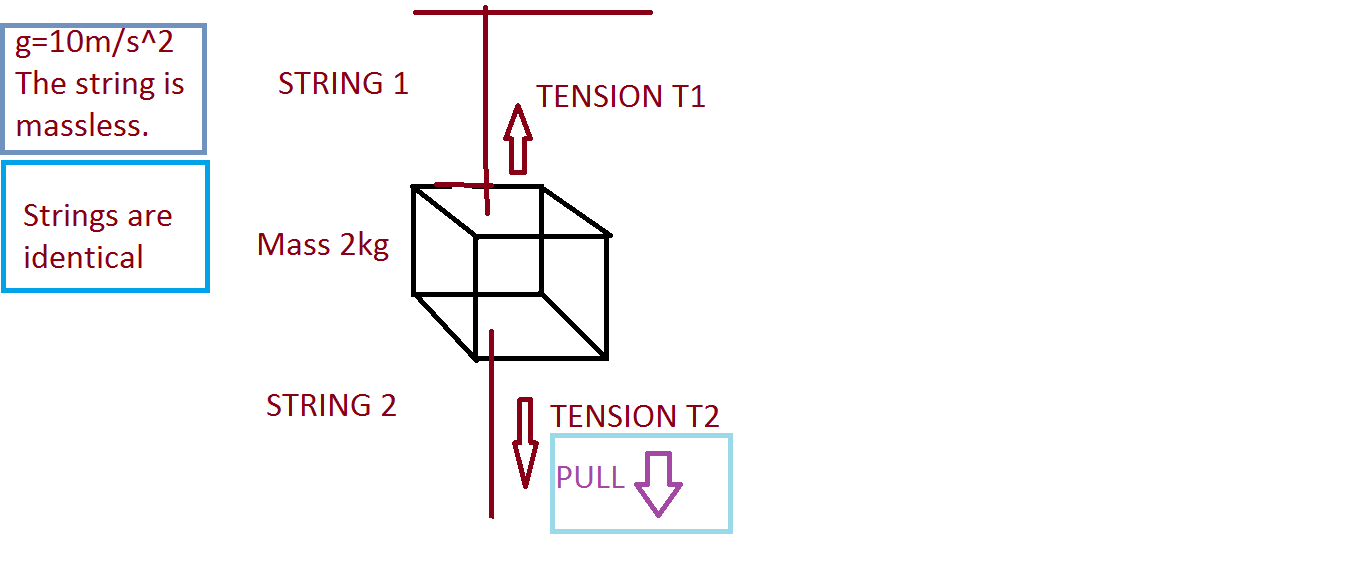DECOY WEIGHT PROBLEM

In the given figure, a pull is applied in the downward direction so our intuition says that the string 1 must break first.It is because initially T1=20 N(weight of block) and T2=0(mass of string is assumed 0).So, the top string must break, nevertheless at MIT an experiment was carried out a few years ago , where in the first case the bottom string broke and the next time it was done ,the top one broke.PLEASE NOTE THAT THIS WAS NOT A PART OF ANY MAGIC SHOW. Here is my explanation for this : Case 1: I put in a pull on the bottom string which initially lied perpendicular the surface.The top string held an object of weight 20 N.Now since our strings our identical, the top string exerts a greater force than the bottom one, so the top string must break at first hand ,but it does not.There is some hidden force which is either increasing T2 or decreasing T1 by the same factor such that it becomes equal.It is quite obvious that this hidden force is gravity which is pulling the block downwards counteracting the tension T1 and thus keeping the whole system at 0 acceleration. Therefore ,the tension T1 became equal to T2 . But as I applied a pull downwards the tension T2 suddenly increased, and it broke. Case 2: Initially tension T1=20 N, T2=0 N.As I pulled ,the tension T1 increased because now it's magnitude was 20N + my pull. During the pull, the block changed it's state of rest and by Newton's first law, a body can change it's state of motion only when applied by an external unbalanced force.So the block accelerated (forget the magnitude).The string 1 now had to pull even harder so as to keep the block from falling.Therefore it broke. Any one can ask that why in this case 'the tension T2 not increase suddenly'? It is because ,that it did increase but only with the value of my pull., while the T1 was way beyond this .One can also say that why didn't in the first case the system experiance a downward acceleration? It is because in the first case the system did not have any time to readjust itself the sudden increase from 0 up to my pull caused string to break.
I do not think the whole of this thing is correct.There is some fallacy in this . If the readers find some better explanation then it is expected to be posted.
Easy Math Editor
This discussion board is a place to discuss our Daily Challenges and the math and science related to those challenges. Explanations are more than just a solution — they should explain the steps and thinking strategies that you used to obtain the solution. Comments should further the discussion of math and science.
When posting on Brilliant:
*italics*or_italics_**bold**or__bold__paragraph 1
paragraph 2
[example link](https://brilliant.org)> This is a quote# I indented these lines # 4 spaces, and now they show # up as a code block. print "hello world"\(...\)or\[...\]to ensure proper formatting.2 \times 32^{34}a_{i-1}\frac{2}{3}\sqrt{2}\sum_{i=1}^3\sin \theta\boxed{123}Comments
There are no comments in this discussion.